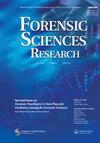Improving accuracy of age estimates for insect evidence—calibration of physiological age at emergence (k) using insect size but without ‘k versus size’ model
IF 1.8
4区 医学
Q3 MEDICINE, LEGAL
引用次数: 0
Abstract
Postmortem interval (PMI) may be estimated based on the age of insect evidence collected on a death scene. Reference data that are used in such estimation frequently comprise thermal summation constant (ie, k), which is equal to the insect age upon completion of immature development expressed in accumulated degree-days or degree-hours (ADD or ADH). Essentially, k is a central point of an insect group and it may poorly represent insect evidence that is near the limits of variation for the group. Accordingly, it was postulated to calibrate k for particular insect evidence and insect size and sex were found to be useful for this purpose in some of the species. However, the calibration is only possible by using the model that correlates k with insect size. Since very few such models were published, this lack of data limits the calibration of k in forensic casework. In this article we develop a formula that is useful for the calibration of k without the use of ‘k versus size’ model (and related datasets). The formula uses k from the general thermal summation model for a species (with its standard error), size range for the species (retrieved from entomology literature) and size measurements for particular insect evidence. The calibration of k with the formula was validated using the Creophilus maxillosus (Coleoptera: Staphylinidae) and Necrodes littoralis (Coleoptera: Silphidae) datasets. It was particularly useful while analyzing unusually small and large insects, in case of which the formula reduced the inaccuracy of k from the general model on average by about 25 ADD in C. maxillosus and about 40 ADD in N. littoralis. We discuss the limitations and prospects of the calibration protocol that employs the formula.提高昆虫证据年龄估计的准确性--使用昆虫体型校准出壳时的生理年龄(k),但不使用 "k 与体型 "模型
可以根据在死亡现场收集到的昆虫证据的年龄来估计死后间隔(PMI)。用于此类估算的参考数据通常包括热和常数(即 k),该常数等于以累积度日或度小时(ADD 或 ADH)表示的昆虫未成熟发育完成时的年龄。从本质上讲,k 是一个昆虫类群的中心点,它可能无法很好地代表接近该类群变异极限的昆虫证据。因此,有人提出了针对特定昆虫证据校准 k 的假设,并发现在某些物种中,昆虫的大小和性别对这一目的很有用。然而,只有使用 k 与昆虫体型相关的模型才能进行校准。由于此类模型很少发表,数据的缺乏限制了法医案件工作中对 k 的校准。在本文中,我们开发了一种公式,可用于在不使用 "k 与昆虫大小 "模型(及相关数据集)的情况下校准 k。该公式使用了物种一般热和模型中的 k(及其标准误差)、物种的大小范围(从昆虫学文献中检索)以及特定昆虫证据的大小测量值。使用该公式校准 k 时,使用了 Creophilus maxillosus(鞘翅目:蝶形目)和 Necrodes littoralis(鞘翅目:蚕科)数据集进行了验证。在分析异常小和异常大的昆虫时,该公式特别有用,在这些昆虫中,该公式将一般模型中 k 的误差平均降低了约 25 ADD(褐翅鞘翅目)和约 40 ADD(绵翅鞘科)。我们讨论了采用该公式的校准方案的局限性和前景。
本文章由计算机程序翻译,如有差异,请以英文原文为准。
求助全文
约1分钟内获得全文
求助全文

 求助内容:
求助内容: 应助结果提醒方式:
应助结果提醒方式:


